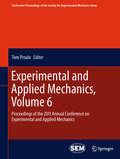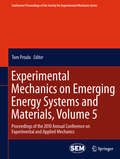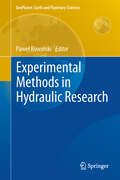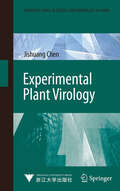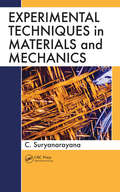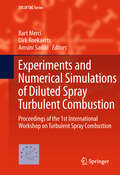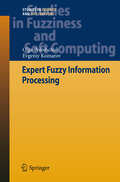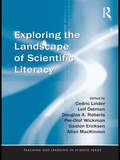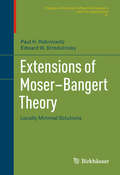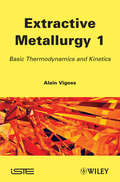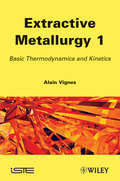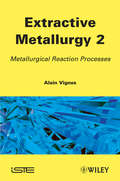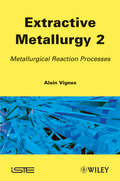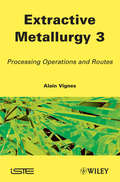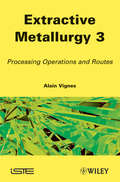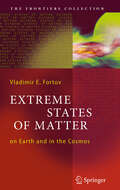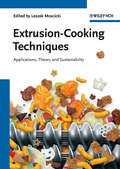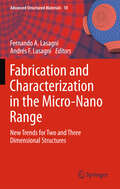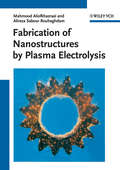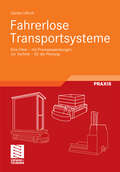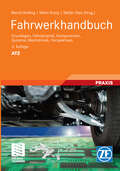- Table View
- List View
Exercise and Disease Management
by Brian C. Leutholtz Ignacio RipollExercise and Disease Management is designed to help managed care physicians, their patients, other health care professionals, and interested readers integrate current exercise guidelines into their practices. This extraordinary book is accompanied by a series of 11 workbooks, each one for a chronic disease, designed specifically for physicians to g
Exoskeletons in Rehabilitation Robotics: Tremor Suppression (Springer Tracts in Advanced Robotics #69)
by Eduardo Rocon José L. PonsThe new technological advances opened widely the application field of robots. Robots are moving from the classical application scenario with structured industrial environments and tedious repetitive tasks to new application environments that require more interaction with the humans. It is in this context that the concept of Wearable Robots (WRs) has emerged. One of the most exciting and challenging aspects in the design of biomechatronics wearable robots is that the human takes a place in the design, this fact imposes several restrictions and requirements in the design of this sort of devices. The key distinctive aspect in wearable robots is their intrinsic dual cognitive and physical interaction with humans. The key role of a robot in a physical human–robot interaction (pHRI) is the generation of supplementary forces to empower and overcome human physical limits. The crucial role of a cognitive human–robot interaction (cHRI) is to make the human aware of the possibilities of the robot while allowing them to maintain control of the robot at all times. This book gives a general overview of the robotics exoskeletons and introduces the reader to this robotic field. Moreover, it describes the development of an upper limb exoskeleton for tremor suppression in order to illustrate the influence of a specific application in the designs decisions.
Experimental and Applied Mechanics, Volume 6: Proceedings of the 2010 Annual Conference on Experimental and Applied Mechanics (Conference Proceedings of the Society for Experimental Mechanics Series #17)
by Tom ProulxThis the sixth volume of six from the Annual Conference of the Society for Experimental Mechanics, 2010, brings together 128 chapters on Experimental and Applied Mechanics. It presents early findings from experimental and computational investigations including High Accuracy Optical Measurements of Surface Topography, Elastic Properties of Living Cells, Standards for Validating Stress Analyses by Integrating Simulation and Experimentation, Efficiency Enhancement of Dye-sensitized Solar Cell, and Blast Performance of Sandwich Composites With Functionally Graded Core.
Experimental and Applied Mechanics, Volume 6: Proceedings of the 2011 Annual Conference on Experimental and Applied Mechanics (Conference Proceedings of the Society for Experimental Mechanics Series #6)
by Tom ProulxExperimental and Applied Mechanics represents one of eight volumes of technical papers presented at the Society for Experimental Mechanics Annual Conference on Experimental and Applied Mechanics, held at Uncasville, Connecticut, June 13-16, 2011. The full set of proceedings also includes volumes on Dynamic Behavior of Materials, Mechanics of Biological Systems and Materials, Challenges in Mechanics of Time-Dependent Materials and Processes in Conventional and Multifunctional Materials, MEMS and Nanotechnology; Optical Measurements, Modeling and, Metrology; Experimental and Applied Mechanics, Thermomechanics and Infra-Red Imaging, and Engineering Applications of Residual Stress.
Experimental Mechanics on Emerging Energy Systems and Materials, Volume 5: Proceedings of the 2010 Annual Conference on Experimental and Applied Mechanics (Conference Proceedings of the Society for Experimental Mechanics Series #16)
by Tom ProulxThis the fifth volume of six from the Annual Conference of the Society for Experimental Mechanics, 2010, brings together 25 chapters on Emerging Energy Systems. It presents early findings from experimental and computational investigations including Material State Changes in Heterogeneous Materials for Energy Systems, Characterization of Carbon Nanotube Foam for Improved Gas Storage Capability, Thermoresponsive Microcapsules for Autonomic Lithium-ion Battery Shutdown, Service Life Prediction of Seal in PEM Fuel Cells, and Assessing Durability of Elastomeric Seals for Fuel Cell Applications.
Experimental Methods in Hydraulic Research (GeoPlanet: Earth and Planetary Sciences)
by Pawel RowinskiIt is clear that hydraulic research is developing beyond traditional civil engineering to satisfy increasing demands in natural hazards assessment and also environmental research. Our ability to describe processes in nature rests on the observation and experimental methods as well as on theoretical basics of various disciplines. Under such conditions experimental methods draw from various areas of human activities and research, i.e. from physics, biology, chemistry, aerospace research, oceanic research etc. The current volume is the result of a meeting that took place during the 30th International School of Hydraulics in Poland and presents both the state-of-the-art and ongoing research projects in which experimental methods play a key role. Authors from numerous leading laboratories and from various countries guarantee a representative sample of different studies at the frontier of the field
Experimental Plant Virology (Advanced Topics in Science and Technology in China)
by Jishuang Chen"Experimental Plant Virology” provides the updated methodology for studying the genomic characterization and mechanisms of infection, the quantitative determination as well as the diagnosis of plant pathogenic viruses. With illustrations showing viral symptoms and ultra-structures, clear and concise descriptions, the book presents the latest developments in experimental plant virology. This book is intended for researchers, university teaching staff, graduate students and undergraduates in plant science. Dr. Jishuang Chen is a professor of plant pathology at the Institute of Bioengineering, Zhejiang Sci-Tech University, China.
Experimental Techniques in Materials and Mechanics
by C. SuryanarayanaExperimental Techniques in Materials and Mechanics provides a detailed yet easy-to-follow treatment of various techniques useful for characterizing the structure and mechanical properties of materials. With an emphasis on techniques most commonly used in laboratories, the book enables students to understand practical aspects of the methods and deri
Experiments and Numerical Simulations of Diluted Spray Turbulent Combustion: Proceedings of the 1st International Workshop on Turbulent Spray Combustion (ERCOFTAC Series #17)
by Bart Merci, Dirk Roekaerts and Amsini SadikiThis book reflects the outcome of the 1st International Workshop on Turbulent Spray Combustion held in 2009 in Corsica (France). The focus is on reporting the progress of experimental and numerical techniques in two-phase flows, with emphasis on spray combustion. The motivation for studies in this area is that knowledge of the dominant phenomena and their interactions in such flow systems is essential for the development of predictive models and their use in combustor and gas turbine design. This necessitates the development of accurate experimental methods and numerical modelling techniques. The workshop aimed at providing an opportunity for experts and young researchers to present the state-of-the-art, discuss new developments or techniques and exchange ideas in the areas of experimentations, modelling and simulation of reactive multiphase flows.The first two papers reflect the contents of the invited lectures, given by experts in the field of turbulent spray combustion. The first concerns computational issues, while the second deals with experiments. These lectures initiated very interesting and interactive discussions among the researchers, further pursued in contributed poster presentations. Contributions 3 and 4 focus on some aspects of the impact of the interaction between fuel evaporation and combustion on spray combustion in the context of gas turbines, while the final article deals with the interaction between evaporation and turbulence.
Expert Fuzzy Information Processing (Studies in Fuzziness and Soft Computing #268)
by Olga Poleshchuk Evgeniy KomarovThis book deals with expert evaluation models in the form of semantic spaces with completeness and orthogonality properties (complete orthogonal semantic spaces). Theoretical and practical studies of some researchers have shown that these spaces describe expert evaluations most adequately, and as a result they were often included in more sophisticated models of intellectual systems for decision making and data analysis. Methods for constructing expert evaluation models of characteristics, comparative analysis of these models, studies of structural composition of their sets and constructing of generalized models are described. Models to obtain rating points for objects and groups of objects with qualitative and quantitative characteristics are presented. A number of regression models combining elements of classical and fuzzy regressions are presented. All methods and models developed by the authors and described in the book are illustrated with examples from various fields of human activities.This book meant for scientists in the field of computer science, expert systems, artificial intelligence and decision making; and also for engineers, post-graduate students and students who study the fuzzy set theory and its applications.
Exploring the Landscape of Scientific Literacy (Teaching and Learning in Science Series)
by Cedric LinderScientific literacy is part of national science education curricula worldwide. In this volume, an international group of distinguished scholars offer new ways to look at the key ideas and practices associated with promoting scientific literacy in schools and higher education. The goal is to open up the debate on scientific literacy, particularly around the tension between theoretical and practical issues related to teaching and learning science. Uniquely drawing together and examining a rich, diverse set of approaches and policy and practice exemplars, the book takes a pragmatic and inclusive perspective on curriculum reform and learning, and presents a future vision for science education research and practice by articulating a more expansive notion of scientific literacy.
Exploring the Landscape of Scientific Literacy (Teaching and Learning in Science Series)
by Cedric Linder Leif Östman Douglas A. Roberts Per-Olof Wickman Gaalen Ericksen Allan MacKinnonScientific literacy is part of national science education curricula worldwide. In this volume, an international group of distinguished scholars offer new ways to look at the key ideas and practices associated with promoting scientific literacy in schools and higher education. The goal is to open up the debate on scientific literacy, particularly around the tension between theoretical and practical issues related to teaching and learning science. Uniquely drawing together and examining a rich, diverse set of approaches and policy and practice exemplars, the book takes a pragmatic and inclusive perspective on curriculum reform and learning, and presents a future vision for science education research and practice by articulating a more expansive notion of scientific literacy.
Extensions of Moser–Bangert Theory: Locally Minimal Solutions (Progress in Nonlinear Differential Equations and Their Applications #81)
by Paul H. Rabinowitz Edward W. StredulinskyThis self-contained monograph presents extensions of the Moser–Bangert approach that include solutions of a family of nonlinear elliptic PDEs on Rn and an Allen–Cahn PDE model of phase transitions. After recalling the relevant Moser–Bangert results, Extensions of Moser–Bangert Theory pursues the rich structure of the set of solutions of a simpler model case, expanding upon the studies of Moser and Bangert to include solutions that merely have local minimality properties. The work is intended for mathematicians who specialize in partial differential equations and may also be used as a text for a graduate topics course in PDEs.
Extractive Metallurgy 1: Basic Thermodynamics and Kinetics (Iste Ser.)
by Alain VignesThis book is dedicated to the processes of mineral transformation, recycling and reclamation of metals, for the purpose of turning metals and alloys into a liquid state ready for pouring. Even though "process metallurgy" is one of the oldest technologies implemented by man, technological innovation, with the development of processes that are both focused on product quality and economically and ecologically efficient, continues to be at the heart of these industries. This book explains the physico-chemical bases of transformations, vital to their understanding and control (optimization of operational conditions), and the foundations in terms of "process engineering" (heat and matter assessment, process coupling: chemical reactions and transport phenomena), vital to the optimal execution and analysis of transformation process operations. This book is addressed to students in the field of metallurgy and to engineers facing the problem of metal and alloy development (operation of an industrial unit or development of a new process).
Extractive Metallurgy 1: Basic Thermodynamics and Kinetics
by Alain VignesThis book is dedicated to the processes of mineral transformation, recycling and reclamation of metals, for the purpose of turning metals and alloys into a liquid state ready for pouring. Even though "process metallurgy" is one of the oldest technologies implemented by man, technological innovation, with the development of processes that are both focused on product quality and economically and ecologically efficient, continues to be at the heart of these industries. This book explains the physico-chemical bases of transformations, vital to their understanding and control (optimization of operational conditions), and the foundations in terms of "process engineering" (heat and matter assessment, process coupling: chemical reactions and transport phenomena), vital to the optimal execution and analysis of transformation process operations. This book is addressed to students in the field of metallurgy and to engineers facing the problem of metal and alloy development (operation of an industrial unit or development of a new process).
Extractive Metallurgy 2: Metallurgical Reaction Processes (Iste Ser.)
by Alain VignesThe Extractive Metallurgy series is devoted to the extraction of metals from ores and other sources, their refining to the state of either liquid or solid metal, and the various processes needed to carry out these operations. Using the methodology of chemical reaction engineering, this second volume in the series examines on the metallurgical reaction processes used in the extraction and refining operations, covering pyrometallurgical, hydrometallurgical, halide, and electro-metallurgical processes. It provides valuable information on the technologies and processes engineers encounter in industrial production.
Extractive Metallurgy 2: Metallurgical Reaction Processes
by Alain VignesThe Extractive Metallurgy series is devoted to the extraction of metals from ores and other sources, their refining to the state of either liquid or solid metal, and the various processes needed to carry out these operations. Using the methodology of chemical reaction engineering, this second volume in the series examines on the metallurgical reaction processes used in the extraction and refining operations, covering pyrometallurgical, hydrometallurgical, halide, and electro-metallurgical processes. It provides valuable information on the technologies and processes engineers encounter in industrial production.
Extractive Metallurgy 3: Processing Operations and Routes (Iste Ser.)
by Alain VignesExtractive metallurgy is the art and science of extracting metals from their ores and refining them. The production of metals and alloys from these source materials is still one of the most important and fundamental industries in both developed and developing economies around the world. The outputs and products are essential resources for the metallic, mechanical, electromagnetic, electrical and electronics industries (silicon is treated as a metal for these purposes). This series is devoted to the extraction of metals from ores, concentrates (enriched ores), scraps, and other sources and their refining to the state of either liquid metal before casting or to solid metals. The extraction and refining operations that are required may be carried out by various metallurgical reaction processes. Extractive Metallurgy 1 deals with the fundamentals of thermodynamics and kinetics of the reaction processes. Extractive Metallurgy 2 focuses on pyrometallurgical, hydrometallurgical, halide and electro-metallurgical (conversion) processes. Extractive Metallurgy 3 deals with the industrial processing operations, technologies, and process routes, in other words the sequence of steps or operations used to convert the ore to metal. Processes and operations are studied using the methodology of “chemical reaction engineering”. As the fundamentals of the art and science of Extractive Metallurgy are infrequently taught as dedicated university or engineering schools courses, this series is intended both for students in the fields of Metallurgy and Mechanical Engineering who want to acquire this knowledge, and also for engineers put in charge of the operation of an industrial production unit or the development of a new process, who will need the basic knowledge of the corresponding technology.
Extractive Metallurgy 3: Processing Operations and Routes
by Alain VignesExtractive metallurgy is the art and science of extracting metals from their ores and refining them. The production of metals and alloys from these source materials is still one of the most important and fundamental industries in both developed and developing economies around the world. The outputs and products are essential resources for the metallic, mechanical, electromagnetic, electrical and electronics industries (silicon is treated as a metal for these purposes). This series is devoted to the extraction of metals from ores, concentrates (enriched ores), scraps, and other sources and their refining to the state of either liquid metal before casting or to solid metals. The extraction and refining operations that are required may be carried out by various metallurgical reaction processes. Extractive Metallurgy 1 deals with the fundamentals of thermodynamics and kinetics of the reaction processes. Extractive Metallurgy 2 focuses on pyrometallurgical, hydrometallurgical, halide and electro-metallurgical (conversion) processes. Extractive Metallurgy 3 deals with the industrial processing operations, technologies, and process routes, in other words the sequence of steps or operations used to convert the ore to metal. Processes and operations are studied using the methodology of “chemical reaction engineering”. As the fundamentals of the art and science of Extractive Metallurgy are infrequently taught as dedicated university or engineering schools courses, this series is intended both for students in the fields of Metallurgy and Mechanical Engineering who want to acquire this knowledge, and also for engineers put in charge of the operation of an industrial production unit or the development of a new process, who will need the basic knowledge of the corresponding technology.
Extreme States of Matter: on Earth and in the Cosmos (The Frontiers Collection)
by Vladimir E. FortovWith its many beautiful colour pictures, this book gives fascinating insights into the unusual forms and behaviour of matter under extremely high pressures and temperatures. These extreme states are generated, among other things, by strong shock, detonation and electric explosion waves, dense laser beams, electron and ion beams, hypersonic entry of spacecraft into dense atmospheres of planets, and in many other situations characterized by extremely high pressures and temperatures.Written by one of the world's foremost experts on the topic, this book will inform and fascinate all scientists dealing with materials properties and physics, and also serve as an excellent introduction to plasma-, shock-wave and high-energy-density physics for students and newcomers seeking an overview.
Extrusion-Cooking Techniques: Applications, Theory and Sustainability
by Leszek MoscickiOffering an engineering perspective and the latest information on the application of this rapidly expanding technique, this practical book covers the technology, engineering, materials and products, as well as economic and ecological aspects. In addition to the theory, it also utilizes case studies that can easily be put into industrial practice. Each step of the process is discussed in terms of sustainability, and all data complies with the EU and FTA environmental regulations. Invaluable reading for food chemists and technologists, process engineers, chemists in industry, agricultural scientists, and chemical engineers. From the Contents: * Engineering Aspects of Extrusion * Raw Materials in the Production of Extrudates * Production of Breakfast Cereals, Snack Pellets, Baby Food and more * Extrusion Technique in Confectionery * Pet Food and Aquafeed * Extrusion-Cooking in Waste Management and Paper Pulp Processing * Thermoplastic Starch * Expanders * Process Automation * Scale-Up of Extrusion-Cooking in Single-Screw Extruders
Fabrication and Characterization in the Micro-Nano Range: New Trends for Two and Three Dimensional Structures (Advanced Structured Materials #10)
by Fernando A. A. Lasagni and Andrés F. F. LasagniThis book shows an update in the field of micro/nano fabrications techniques of two and three dimensional structures as well as ultimate three dimensional characterization methods from the atom range to the micro scale. Several examples are presented showing their direct application in different technological fields such as microfluidics, photonics, biotechnology and aerospace engineering, between others. The effects of the microstructure and topography on the macroscopic properties of the studied materials are discussed, together with a detailed review of 3D imaging techniques.
Fabrication of Nanostructures by Plasma Electrolysis
by Mahmood Aliofkhazraei Alireza Sabour RouhaghdamIn this handbook and ready reference, the authors introduce the concept of plasma electrolysis, explaining how the coatings are characterized and discussing their mechanical and corrosion properties. They then go on to look at specific industrial applications of this powerful and low-cost method, including aerospace, the biomaterials industry as well as in the oil and gas industry.
Fahrerlose Transportsysteme: Eine Fibel - mit Praxisanwendungen - zur Technik - für die Planung (Fortschritte der Robotik #22)
by Günter UllrichFahrerlose Transportsysteme sind flexible, aber mitunter komplexe Materialflusssysteme für die Intralogistik. Die Marktdurchdringung in den bekannten Anwendungsbereichen wächst ebenso wie die Chancen in neuen Märkten. Der Anwender und Planer solcher Systeme hat die Möglichkeit, große Rationalisierungspotentiale in seiner Intralogistik zu schöpfen, braucht dafür aber umfangreiche Informationen. Die FTS-Fibel zeigt, wie und wo man FTS einsetzen kann und wie die wichtigsten technischen Komponenten aufgebaut sind. Darüber hinaus bietet sie praxisnahe Planungsunterstützung.
Fahrwerkhandbuch: Grundlagen, Fahrdynamik, Komponenten, Systeme, Mechatronik, Perspektiven (ATZ/MTZ-Fachbuch)
by Bernhard Heißing Metin Ersoy Stefan GiesTrotz aller Unterstützung durch elektronische Steuerungs- und Regelsysteme kommen Pkw-Fahrwerke der neuesten Generation nicht ohne die konventionellen Fahrwerkelemente aus. Mit Blick auf die Fahrdynamik werden in diesem Band die konventionellen Elemente und deren Zusammenwirken mit mechatronischen Systemen dargestellt. Dabei werden zunächst Grundlagen und Auslegung, danach in besonders praxisnaher Darstellung die Fahrdynamik beschrieben. Es folgen ausführliche Beschreibung und Erläuterung der modernen Komponenten. Ein eigener Abschnitt widmet sich den Achsen und Prozessen für die Achsenentwicklung.



